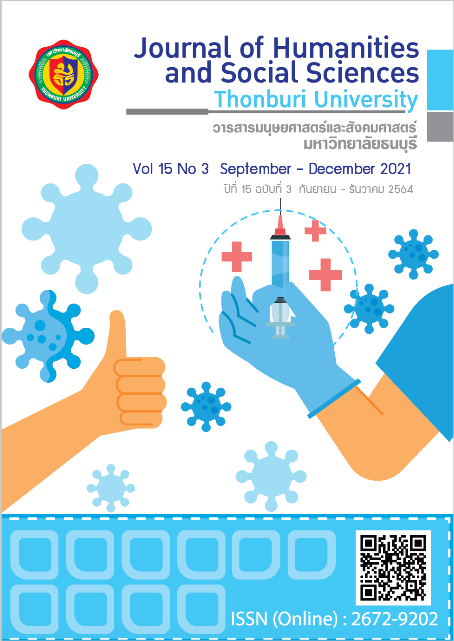ปัจจัยที่ส่งผลต่อการเลือกใช้บริการสายการบินในช่วงการแพร่ระบาดของไวรัส COVID-19
Main Article Content
บทคัดย่อ
การแพร่ระบาดของเชื้อไวรัสโควิด 19 (COVID-19) ส่งผลให้การเดินทางระหว่างประเทศหยุดชะงัก มาตราการต่างๆ ถูกนำมาใช้เพื่อป้องกันและชะลอการแพร่ระบาดของเชื้อไวรัส ที่ผ่านมาได้มีการศึกษาเกี่ยวกับปัจจัยในการเลือกใช้บริการสายการบินของผู้โดยสาร อย่างไรก็ดีในช่วงเวลาที่เกิดการแพร่ระบาดของโรคติดต่อ อาจมีปัจจัยอื่นซึ่งมีความสำคัญต่อการตัดสินใจเลือกใช้สายการบินของผู้โดยสาร นอกเหนือจากปัจจัยที่เคยมีผู้ศึกษามาแล้ว บทความนี้มีวัตถุประสงค์เพื่อสำรวจปัจจัยที่มีความสำคัญต่อการตัดสินใจเลือกใช้บริการสายการบินของผู้โดยสารภายใต้สถานการณ์การแพร่ระบาดของเชื้อไวรัส โควิด 19 ผู้วิจัยเก็บข้อมูลจากแบบสอบถามออนไลน์ และทำการวิเคราห์ข้อมูลโดยวิธี การวิเคราะห์องค์ประกอบเชิงสำรวจ และการวิเคราะห์ความแปรปรวน ผลการวิจัยแสดงให้เห็นว่ามาตราการป้องกันการแพร่ระบาดของโรคติดต่อที่สายการบินนำมาใช้ เป็นปัจจัยสำคัญในการเลือกใช้บริการสายการบิน นอกจากนี้ปัจจัยด้าน ราคา การบริการ และความปลอดภัยเป็นปัจจัยที่มีความสำคัญเช่นกัน ผลการศึกษายังชี้ให้เห็นว่ากลุ่มตัวอย่างที่มีลักษณะทางประชากรศาสตร์แตกต่างกันให้ความสำคัญต่อปัจจัยแต่ละประเภทในระดับที่ต่างกัน
Article Details
References
Bakewell, C., & Mitchell, V.-W. (2006). Male versus female consumer decision making styles. Journal of Business Research, 59(12), 1297–1300.
Bartlett, M. S. (1954). A Note on the Multiplying Factors for Various χ2 Approximations. Journal of the Royal Statistical Society: Series B (Methodological), 16(2), 296–298.
Calisir, N., Basak, E., & Calisir, F. (2016). Key drivers of passenger loyalty: A case of Frankfurt-Istanbul flights. Journal of Air Transport Management, 53, 211–217.
Chen, H.-T., & Chao, C.-C. (2015). Airline choice by passengers from Taiwan and China: A case study of outgoing passengers from Kaohsiung International Airport. Journal of Air Transport Management, 49, 53–63.
Chen, X., Ran, L., Liu, Q., Hu, Q., Du, X., & Tan, X. (2020). Hand hygiene, mask-wearing behaviors and its associated factors during the COVID-19 epidemic: a cross-sectional study among primary school students in Wuhan, China. International Journal of Environmental Research and Public Health, 17(8), 2893.
Chou, P.-F., & Lu, C.-S. (2011). An evaluation of influenza preventive measures on airlines: A passenger's perspective. Journal of Air Transport Management, 17(4), 228–230.
Clemes, M. D., Gan, C., Kao, T., & Choong, M. (2008). An empirical analysis of customer satisfaction in international air travel. Innovative Marketing, 4(2), 49-62.
Correia, S., Luck, S., & Verner, E. (2020). Pandemics depress the economy, public health interventions do not: Evidence from the 1918 flu. Retrieved April 29, 2021, from https://papers.ssrn.com/sol3/papers.cfm?abstract_id=3561560&fbclid=IwAR12PlW6kd83AKq0BX7SOJaIeRaALyAgcrgR2iMZeia2hsbRsBaf9dpMyJM
Field, A. P. (2009). Discovering statistics using SPSS: And sex, drugs and rock "n" roll. (3rd ed). London, United Kingdom: SAGE Publications.
Fleischer, A., Tchetchik, A., & Toledo, T. (2012). The impact of fear of flying on travelers' flight choice: Choice model with latent variables. Journal of Travel Research, 51(5), 653–663.
Forgas, S., Moliner, M. A., Sánchez, J., & Palau, R. (2010). Antecedents of airline passenger loyalty: Low-cost versus traditional airlines. Journal of Air Transport Management, 16(4), 229–233.
Hair Jr., J.F., Anderson, R.E., & Tatham, R.L. (1987). Multivariate Data Analysis. New York: Mcmillan.
IATA. (2020). Guidance for Cabin Operations During and Post Pandemic. Edition 1-22 April 2020. Retrieved September 20, 2020, from https://www.skybrary.aero/bookshelf/books/5660.pdf
ICAO. (2020). Effects of Novel Coronavirus (COVID-19) on Civil Aviation: Economic Impact Analysis. Retrieved September 20, 2020, from https://www.icao.int/sustainability/Documents/COVID-19/ICAO_Coronavirus_Econ_Impact.pdf
Kaiser, H. F. (1974). An index of factorial simplicity. Psychometrika, 39, 31-36.
Kim, S. B., & Park, J. W. (2017). A study on the importance of airline selection attributes by airline type: An emphasis on the difference of opinion in between Korean and overseas aviation experts. Journal of Air Transport Management, 60, 76–83.
Korzeniewski, K. (2017). Travel health prevention. International Maritime Health, 68(4), 238-244.
Kunst, A. (2019), Frequent flyer program members in the United Kingdom (UK) 2017, by income group. Statista. Retrieved October, 15, 2020, from https://www.statista.com/statistics/675713/frequent-flyer-program-members-united-kingdom-uk-by-income/.
Loureiro, S. M. C., & Fialho, A. F. (2017). The role of intrinsic in-flight cues in relationship quality and behavioural intentions: segmentation in less mindful and mindful passengers. Journal of Travel and Tourism Marketing, 34(7), 948–962.
Machida, M., Nakamura, I., Saito, R., Nakaya, T., Hanibuchi, T., Takamiya, T., Odagiri, Y., Fukushima, N., Kikuchi, H., Kojima, T., Watanabe, H., & Inoue, S. (2020). Adoption of personal protective measures by ordinary citizens during the COVID-19 outbreak in Japan. International Journal of Infectious Diseases, 94, 139–144.
Mangili, A., & Gendreau, M. A. (2005). Transmission of infectious diseases during commercial air travel. The Lancet, 365(9463), 989–996.
Martinez-Garcia, E., & Royo-Vela, M. (2010). Segmentation of low-cost flights users at secondary airports. Journal of Air Transport Management, 16(4), 234–237.
Medina-Muñoz, D. R., Medina-Muñoz, R. D., & Suárez-Cabrera, M. Á. (2018). Determining important attributes for assessing the attractiveness of airlines. Journal of Air Transport Management, 70, 45–56.
O'Connell, J. F., & Williams, G. (2005). Passengers' perceptions of low cost airlines and full service carriers: A case study involving Ryanair, Aer Lingus, Air Asia and Malaysia Airlines. Journal of Air Transport Management, 11(4), 259–272.
Pallant, J. (2010). SPSS Survival Manual (4th ed). Berkshire, England: Open University Press.
Park, J. W. (2010). The effect of frequent flyer programs: A case study of the Korean airline industry. Journal of Air Transport Management, 16(5), 287–288.
Park, J. W., Robertson, R., & Wu, C. L. (2004). The effect of airline service quality on passengers' behavioural intentions: A Korean case study. Journal of Air Transport Management, 10(6), 435–439.
Patel, H., & D'Cruz, M. (2018). Passenger-centric factors influencing the experience of aircraft comfort. Transport Reviews, 38(2), 252–269.
Sezgen, E., Mason, K. J., & Mayer, R. (2019). Voice of airline passenger: A text mining approach to understand customer satisfaction. Journal of Air Transport Management, 77, 65–74.
So, K. K. F., King, C., Hudson, S., & Meng, F. (2017). The missing link in building customer brand identification: The role of brand attractiveness. Tourism Management, 59, 640–651.
Tang, C. S., & Wong, C. (2004). Factors influencing the wearing of facemasks to prevent the severe acute respiratory syndrome among adult Chinese in Hong Kong. Preventive Medicine, 39(6), 1187–1193.
The Civil Aviation Authority of Thailand. (2020). Air Transport Statistics. Retrieved April, 15, 2021, from https://www.caat.or.th/th/archives/49463
Wafik, G. M., Abou-Shouk, M. A., & Hewedi, M. M. (2017). Airline passenger travel cycle, satisfaction and loyalty: A comparison of EgyptAir and Emirates Airlines. International Journal of Hospitality and Tourism Systems, 10, 83-94.
Wen, C. H., & Lai, S. C. (2010). Latent class models of international air carrier choice. Transportation Research Part E: Logistics and Transportation Review, 46(2), 211–221.
Yamane, T. (1967). Statistics: An introductory analysis. New York, NY: Harper & Row.
Zhang, Y. (2012). Are Chinese passengers willing to pay more for better air services? Journal of Air Transport Management, 25, 5–7.

